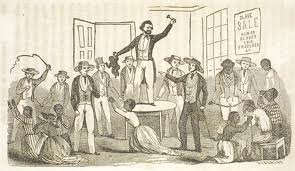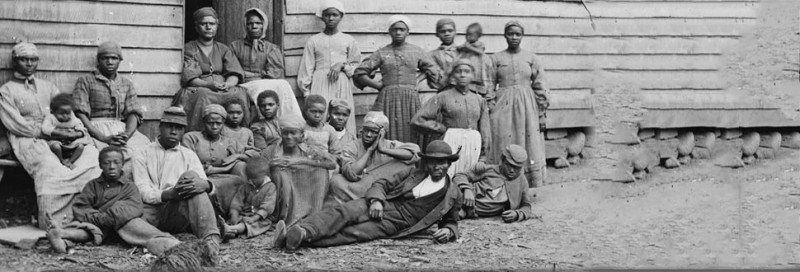How Slavery Became the Law of the Land “For Blacks Only”
Share
Most Recent Exhibit
Breaking News!
Today's news and culture by Black and other reporters in the Black and mainstream media.
Ways to Support ABHM?
Scholar-Griot: Robert S. Smith, PhD
Copy and Photo Editor: Fran Kaplan, EdD
Servants in Our First Town
Jamestown was founded in 1607 by the Virginia Company. It was the first English settlement in what later became the United States. The Virginia Company established Jamestown to profit from the area’s natural resources. The area already belonged to the Powhatan Confederacy. Over fourteen thousand Native Americans lived there.
The first meetings between English settlers and Indians were peaceful. The English struggled to grow food, because they had arrived in May, missing the best time to plant crops. Local Indians fed them, but soon English demands for the Indians’ goods and land led to conflicts.
In 1619 the first Africans arrived in Jamestown. These Africans were Creoles, meaning they had cultural roots that were both African and European. They may have been of mixed race, since Africans, the Portuguese and the Spanish had already been trading goods and human labor for several hundred years.
When these first Africans arrived, they were indentured servants, not slaves. African indentured servants did the same work as European indentured servants. After several years of working, indentured servants became free and acquired land.
The Rise of Race-Based Slavery
The system of basing slavery on a person’s race did not occur in the first years of settlement. Race-based slavery began in the mid-1600s. By the 1660s, slavery was reserved for Africans only.
With a series of laws passed from the 1660s to the 1680s, slavery became codified. With these laws, blacks became slaves for life.
Here are some of the laws in Virginia:
1662 – A child born to a slave mother is a slave. A child born to a free mother is free.
1667 – Becoming baptized will not free a slave.
1669 – A slave master – or person acting under the master’s orders – cannot be charged with murder for killing his slave, since the slave is his own property.
1670 – No Indian or free negro can purchase a Christian, but they can purchase Indians and negroes.
1670 – All non-Christian servants shipped to the Virginia Colony are declared slaves for life.
Legal Slavery Spreads Throughout the Colonies
During the 17th and 18th centuries, Virginia showed the other colonies how to legally sanction human bondage based on race. Even northern colonies with limited need for slaves established race-based slavery. So did those that were founded on religious principles, such as Massachusetts and Pennsylvania. As more colonies were founded and began to form into a nation, slavery spread everywhere. It was legal, and it was reserved for Africans.
With Liberty and Justice for... Some
In 1776 our new nation was declared, based on principles of freedom, justice and equality. Despite this, when the Founding Fathers wrote the Constitution, slavery was fully recognized in law and custom. Black people, the majority of whom were enslaved, were generally seen as inferior to whites. The few free blacks lived under race oppression that was close to slavery.
Our Constitution recognizes slavery in three clear places:
Article 1, Section 2 - The number of Representatives in the House will be apportioned according to the number of people in each state. Slaves will count as three-fifths of a person.
Article 1, Section 9 - The importation of slaves cannot be outlawed by any state before 1808.
Article IV, Section 2 - Runaway slaves must be returned to their masters.
The End of Slavery – Sort of...
By the 1800s, some northern states began passing laws to gradually end legal slavery. There was tension over this disagreement between laws in the North and South. This conflict led to the Fugitive Slave Laws, which made it easier for slave owners to recapture their runaway property. It also made it hard for free blacks to prove they were not slaves. The most infamous, incorrect and nefarious ruling in the history of the Supreme Court occurred in the case of Dred Scott v. Sandford (1857), when the Court stated:
The question is simply this: Can a negro, whose ancestors were imported into this country, and sold as slaves become a member of the political community formed and brought into existence by the Constitution of the United States?...
We think they are not, and that they are not included under the word “citizen” in the Constitution and can therefore claim none of the rights and privileges which that instrument provides…
No one of that race had ever migrated to the United States voluntarily; all of them had been brought here as articles of merchandise…and so far inferior, that they had no rights which the white man was bound to respect.
The fight over runaway slaves led to the outbreak of the Civil War. In 1865, when the Civil War ended, the 13th Amendment1 to the U.S. Constitution was adopted. This amendment outlawed slavery – except as punishment for a crime. The crime provision, however, opened the way for new legal tricks that forced blacks to serve as unpaid laborers.
The 14th Amendment2 made full citizenship for African Americans the law, and the 15th Amendment3 gave African Americans the right to vote. However, the Reconstruction Era saw those promises get stripped away by white Southerners as the Jim Crow Era emerged.
Endnotes
1The full text of the 13th Amendment:
Section 1. Neither slavery nor involuntary servitude, except as a punishment for crime whereof the party shall have been duly convicted, shall exist within the United States, or any place subject to their jurisdiction.
Section 2. Congress shall have power to enforce this article by appropriate legislation.
2The full text of the 14th Amendment:
Section 1. All persons born or naturalized in the United States, and subject to the jurisdiction thereof, are citizens of the United States and of the State wherein they reside. No State shall make or enforce any law which shall abridge the privileges or immunities of citizens of the United States; nor shall any State deprive any person of life, liberty, or property, without due process of law; nor deny to any person within its jurisdiction the equal protection of the laws.
Section 2. Representatives shall be apportioned among the several States according to their respective numbers, counting the whole number of persons in each State, excluding Indians not taxed. But when the right to vote at any election for the choice of electors for President and Vice President of the United States, Representatives in Congress, the Executive and Judicial officers of a State, or the members of the Legislature thereof, is denied to any of the male inhabitants of such State, being twenty-one years of age, and citizens of the United States, or in any way abridged, except for participation in rebellion, or other crime, the basis of representation therein shall be reduced in the proportion which the number of such male citizens shall bear to the whole number of male citizens twenty-one years of age in such State.
Section 3. No person shall be a Senator or Representative in Congress, or elector of President and Vice President, or hold any office, civil or military, under the United States, or under any State, who, having previously taken an oath, as a member of Congress, or as an officer of the United States, or as a member of any State legislature, or as an executive or judicial officer of any State, to support the Constitution of the United States, shall have engaged in insurrection or rebellion against the same, or given aid or comfort to the enemies thereof. But Congress may, by a vote of two-thirds of each House, remove such disability.
Section 4. The validity of the public debt of the United States, authorized by law, including debts incurred for payment of pensions and bounties for services in suppressing insurrection or rebellion, shall not be questioned. But neither the United States nor any State shall assume or pay any debt or obligation incurred in aid of insurrection or rebellion against the United States, or any claim for the loss or emancipation of any slave; but all such debts, obligations and claims shall be held illegal and void.
Section 5. The Congress shall have power to enforce, by appropriate legislation, the provisions of this article.
3The full text of the 15th Amendment:
Section 1. The right of citizens of the United States to vote shall not be denied or abridged by the United States or by any State on account of race, color, or previous condition of servitude.
Section 2. The Congress shall have power to enforce this article by appropriate legislation.
Dr. Robert Smith is a professor of African American history and US Legal History at the University of Wisconsin–Milwaukee.
In the past, he taught in the Africana Studies Department of the University of North Carolina–Charlotte. There he was also an invited scholar and consultant to the Levine Museum of the New South, where he helped revamp a permanent exhibit, and an invited scholar/expert for the North Carolina Humanities Council.
Dr. Smith has written a book on Race, Labor & Civil Rights: Griggs v. Duke Power and the Struggle for Equal Employment Opportunity, refereed articles, and book chapters about a variety of topics in African American history and studies. He is currently co-authoring a scholarly edition of A Time of Terror by ABHM founder James Cameron.
Dr. Smith is ABHM’s resident historian and the board member in charge of university-museum relations.
Funding for this exhibit was provided by the Wisconsin Humanities Council:
![]()
Comments Are Welcome
Note: We moderate submissions in order to create a space for meaningful dialogue, a space where museum visitors – adults and youth –– can exchange informed, thoughtful, and relevant comments that add value to our exhibits.
Racial slurs, personal attacks, obscenity, profanity, and SHOUTING do not meet the above standard. Such comments are posted in the exhibit Hateful Speech. Commercial promotions, impersonations, and incoherent comments likewise fail to meet our goals, so will not be posted. Submissions longer than 120 words will be shortened.
See our full Comments Policy here.






















very disappointed about the museum being closed. had planned to stop there on a trip primarily to see the museum. the video did not anything – only heard voice. the info is outstanding on this site and I am really sorry hat I did not visit the area before. first time in your state. will bypass your city now!!
I hope your museum reopens. How much do you need to reopen, and what can our community around the globe do to help?
Thanks for the support and caring, Resa! We are grateful for donations of funds, small and large, to help us re-open once the coronavirus pandemic is behind us. We also appreciate donations of expertise, so if you are a scholar in this field or know someone who is, you can contribute an exhibit or two in your field. See the Contribute page for further information.
This museum is absolutely wonderful, and very much needed. Our ancestors spirits are crying out from beneath the soil, because of the horrors of inhuman treatment they suffered at the hands of an evil, vile system of oppression. May G-d continue to bless you for the love you has expressed in sharing your knowledge… Thank you !
[…] How Slavery Became the Law of the Land “For Blacks Only” […]
[…] How Slavery Became the Law of the Land “For Blacks Only” […]
[…] It descended to us from authoritarian ramparts, by way of colonial subjugation, race-based slavery and violent ethnic cleansing. No wonder that the capitalist market is a bare-knuckled fight in […]